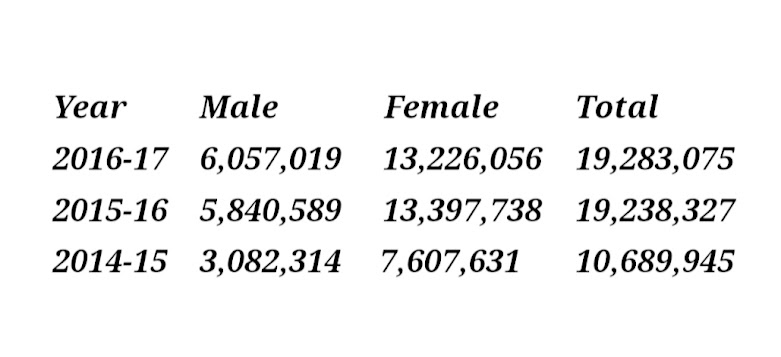Adult Education In India
Adult Education In India
( By Rounakshi Dey )
 |
| Image By:- Sukriti Singh |
What was the last time you checked the literacy rate in India? Maybe a few years back out of a whim. We, the educated folks in India never paid any heed to the literacy rate of our country. We do not even know the condition of the education system, persisting in our rural areas. India has a literacy rate of just 74.04 percent. Not all our brothers and sisters are capable of even signing their names, hence we still haven’t reached a literacy rate of 100 percent. Now, let us define Education. Education is said to be a unique investment for our present and our future. Education brings about the overall development of an individual. It imparts moral values, social norms, textual knowledge, practical examples, and the list continues. It makes us a complete individual. This process of education begins from our childhood. We get enrolled in schools then we get into colleges and then in universities.
But is this the only form of education? The answer is No. Education is primarily of two types: Formal Education and Informal Education. Formal Education is consciously planned for the modification of behavior with a particular end in view. It is undertaken in schools or institutions, established and maintained for this purpose. It has begun since our childhood as we get enrolled in nursery classes. However the main disadvantage of this formal education is that it has a specific time frame, we cannot start our formal education at any age that we like. Informal Education, on the other hand, refers to education that we receive from our practical life. This education can be undertaken at any point in time. There are no specialized organizations teaching us informal education. Often we hear an auto-rickshaw driver, saying that he has never been to school. Yet he is perfect in his calculation while returning the balance of the fare to his customers. He has probably learned numbers, addition, and subtraction from his elders. He does not know any higher mathematics but he definitely knows the basic mathematics he requires to earn this livelihood. Examples like this are common in our daily lives. Most of the people in our country are informally educated.
Adult Education refers to providing educational facilities for adults who could not undergo a regular course of formal education during their school ages. With the view of Adult Education in mind, Government of India had launched a series of programs, as a part of the five year Plan, the most prominent among them being the National Literacy Mission launched in 1988, with an objective to impart literacy to the non-literates in the age group of 15-35 in a time-bound manner. By the end of the 10th 5 year Plan, this plan successfully made 127.45 million people across the Nation, literates. Both the central government and the state government together contribute and promote adult education in the nation. We have a dedicated wing in the Ministry of Human Resource Development that solely looks after the adult education in our country.
The Saakshar Bharat Programme was formulated in the year 2009, with the objective of achieving 80% literacy level throughout the nation. It has four broader objectives, namely imparting functional literacy and numeracy to non-literates; acquiring equivalency to the formal educational system; imparting relevant skill development programs; and promoting a learning society by providing opportunities for continuing education. It was mainly targeted towards female education and education of the minorities in India. India has a huge disparity among male and female literacy rates. This program was targeted at reducing the huge gap between male and female education. This mission was undertaken at the district level. Each district was divided into parts based on the literacy rate of those parts. Places showing poorer literacy rates compared to others were combined together and this plan was implemented there.
Apart from the government, various NGOs have taken up the wing of Adult Education. Our government provides funds to these NGOs under two schemes: (i) Assistance to Voluntary Agencies in the field of Adult Education and (ii) Jan Shikshan Sansthan's. These two schemes aim at one single aspect providing adult education in our Nation. Adult Education hasn’t been only restricted to providing formal textual education among the citizens, it also aims at developing various soft skills among the women in the villages. These NGOs go to the villages, conduct workshops, teach different soft skills like weaving, embroidery, etc. to the housewives and allow them to earn their livelihood. This improves the overall economic status of these women in the society.
Adult Education is a necessity in a developing country like India. Education can never be formally tied to a particular age. Everyone should get a fair chance of getting educated. Education should be our birthright. Our government and various NGOs are actively working towards the betterment of society. It’s time we should do our bit. Maybe we can start with our house help or her children. We can take out an hour or two in the entire week to teach these ill-fated people. If every privileged citizen takes this as her responsibility, it won’t be far when our nation will proudly achieve a 100 percent literacy rate.
No. of Beneficiaries under Adult Education Programme (Sakshar Bharat) - Source: MHRD,2018
Also, Budget expenditure (across Centre & State) on the Adult Education Programme increased from 947 crores in 2012-2013 to 1456 crores in 2014-2015
Disclaimer:-
The opinions expressed in this article are the personal opinions of the author. The facts and opinions appearing in the article do not reflect the views of Light de Literacy and LDL does not assume any responsibility or liability for the same.







Informative article emphasizing on Adult Education.
ReplyDelete